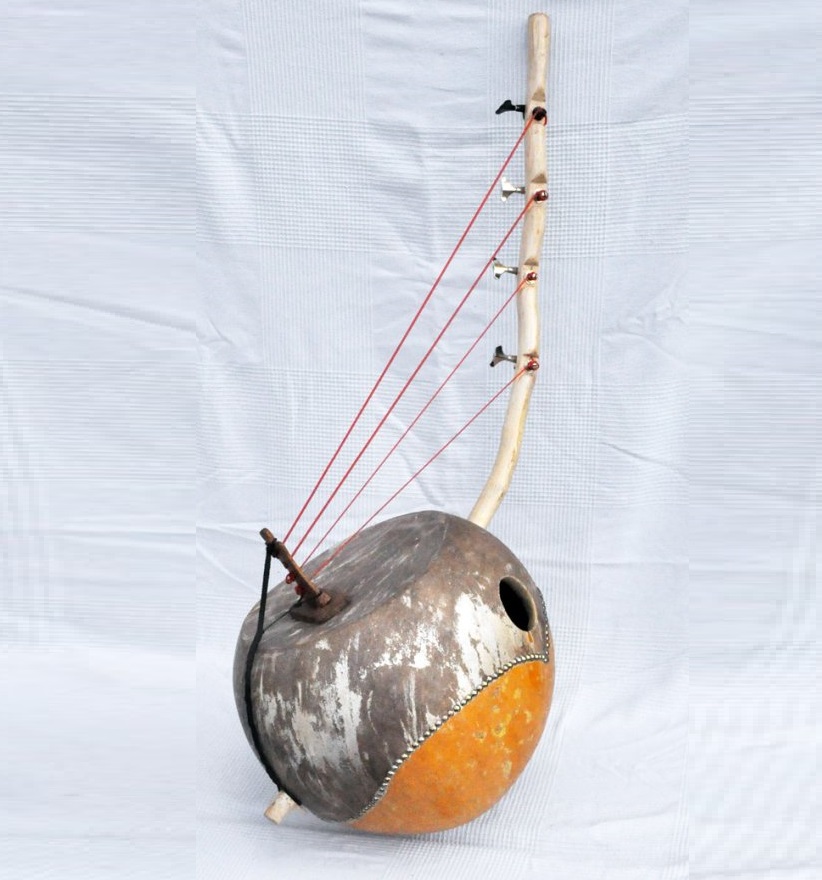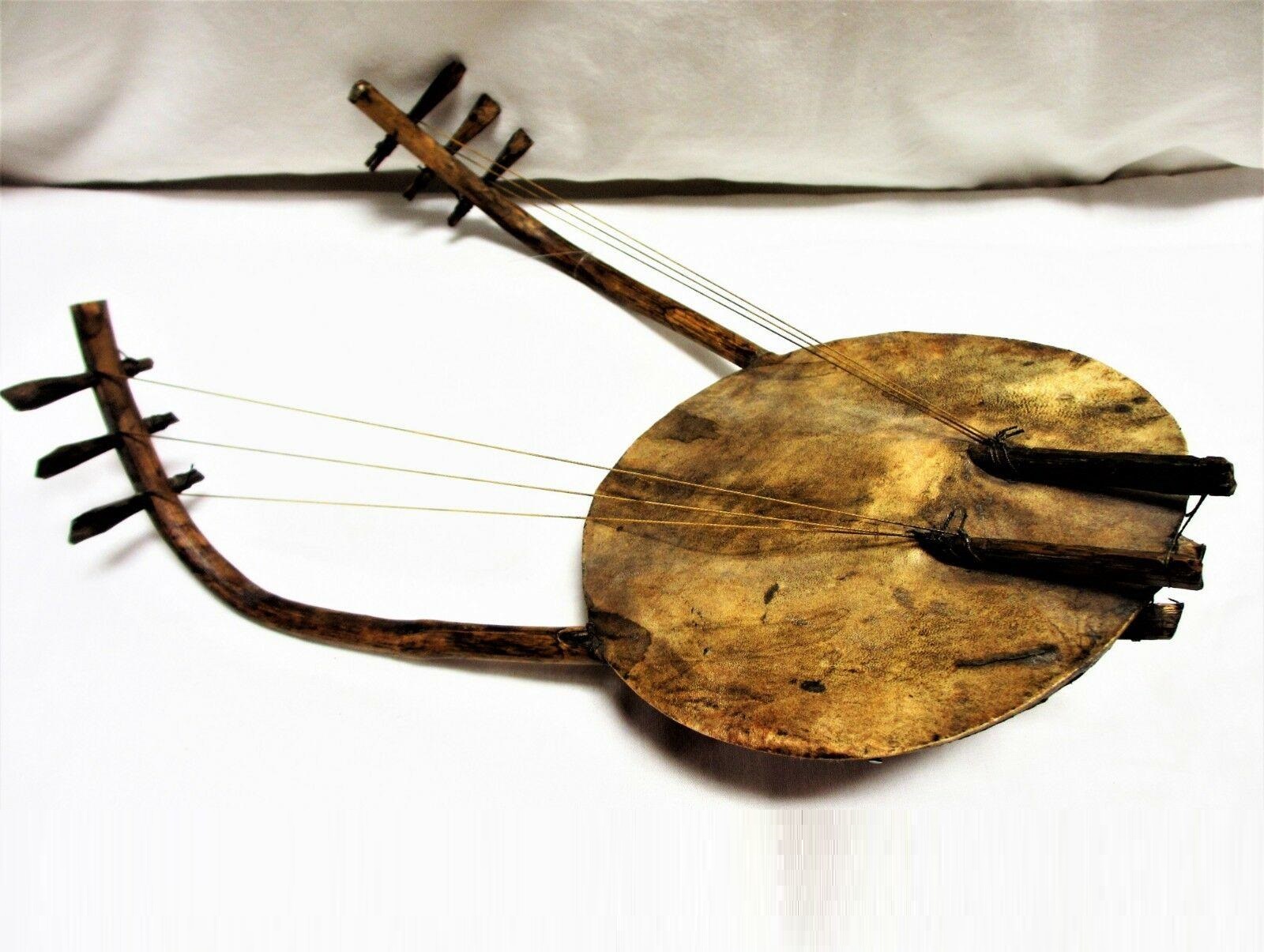Bolon
Percussions
Africa
Between 1001 and 1900 AD
Video
The Bolon is a traditional African harp-lute with a deep cultural significance, primarily associated with the Manding people of West Africa. It is characterized by its distinct design, incorporating a large gourd or calabash as a resonating chamber, a curved wooden neck, and a set of strings that are plucked to produce sound.
This instrument is both a musical and symbolic artifact, often played in ritualistic and ceremonial settings. Unlike Western stringed instruments, the Bolon is deeply rooted in oral traditions, passed down through generations of griots (storytellers and musicians) who use it to convey historical narratives and social messages. The Bolon has a unique tonal quality that varies depending on the materials used in its construction and the technique employed by the musician. It can produce deep, resonant bass notes, as well as higher-pitched tones, making it a versatile instrument within traditional ensembles. Due to its association with warriors and hunters in West African history, the Bolon is also seen as a symbol of power and heritage.
Type of Instrument
The Bolon is classified as a stringed instrument, specifically a harp-lute. It shares similarities with other African stringed instruments, such as the Kora and the Ngoni, but it possesses distinct characteristics that set it apart. Being both a plucked and percussive instrument, the Bolon creates a rhythmic and melodic interplay that enhances storytelling and ceremonial performances. It falls under the chordophone family, which includes other stringed instruments played through plucking or bowing.
History
The history of the Bolon dates back several centuries and is predominantly linked to West Africa, particularly the Manding regions, which encompass present-day Mali, Guinea, Senegal, and Burkina Faso. Scholars believe that the instrument emerged around the 12th to 14th centuries, coinciding with the rise of the Mali Empire under the leadership of Sundiata Keita. The Bolon was historically played by warriors, hunters, and griots who were responsible for preserving oral traditions and reinforcing social structures through music. As an instrument of both music and symbolism, the Bolon was often used in ceremonies related to war, hunting, and spiritual practices. It was believed to possess protective and mystical qualities, with some traditions considering it an instrument of communication between the living and the ancestral spirits. The decline of its use in contemporary times can be attributed to modernization and the influence of Western musical instruments, though efforts are being made to revive and preserve its traditional role.
Construction and Design
The construction of the Bolon reflects the ingenuity and resourcefulness of West African craftsmanship. The instrument is typically made from natural materials, ensuring that it maintains a deep connection with the environment and cultural heritage. The main components of the Bolon include:
Resonating Body: A large gourd or calabash serves as the resonator, amplifying the sound produced by the strings. The gourd is often covered with animal hide, such as goat or cow skin, which helps produce a warm and resonant tone.
Neck: A curved wooden stick, often made from sturdy hardwood, is attached to the gourd. The curvature of the neck is a distinctive feature that contributes to the instrument’s ergonomic playability.
Strings: Traditionally, the strings of the Bolon were made from animal gut, though modern variations may use nylon or metal wires. The number of strings varies, typically ranging from three to four.
Bridge: A simple wooden bridge is used to elevate the strings and transmit vibrations to the resonating body.
Tuning Mechanism: The tuning of the Bolon is achieved by adjusting the tension of the strings, which can be altered by either tightening or loosening them around wooden pegs or leather straps.
Types of Bolon
Although the fundamental design of the Bolon remains consistent, variations exist across different regions and cultural contexts. The primary types of Bolon include:
Traditional Bolon: This is the classic version, typically featuring three or four strings and used in ceremonial settings.
Modern Adaptations: Some contemporary musicians have modified the Bolon by incorporating additional strings and tuning mechanisms to expand its musical range and adaptability to different genres.
Regional Variants: Different ethnic groups in West Africa may have slight variations in the shape, size, and tuning of the Bolon, reflecting local customs and playing styles.
Characteristics and Sound
The sound of the Bolon is deeply resonant, with a warm and earthy quality. It produces a combination of percussive and melodic tones, giving it a unique voice that differs from other stringed instruments. The range of the instrument is relatively limited, but through skillful playing techniques, musicians can create a variety of tonal variations. The tone of the Bolon is often described as rich, organic, and rhythmic, making it an essential instrument in traditional ensembles and contemporary fusion music.
Playing Techniques and Sound Modifications
Playing the Bolon requires a combination of plucking and percussive techniques. Musicians use their fingers to pluck the strings while sometimes striking the body of the instrument to create a rhythmic effect. Some players also use their palms to mute certain strings, allowing for more controlled and dynamic sounds.
One of the most distinctive features of Bolon playing is the use of sound modifications. The musician can vary the pressure applied to the strings, producing slight pitch bends and vibrato effects. Additionally, some players incorporate vocal elements, using the Bolon as an accompaniment to chanting or singing. Other modifications include attaching metal rings or beads to the strings, which create a buzzing effect when the instrument is played. Some modern players experiment with amplification and electronic effects to integrate the Bolon into contemporary musical genres.
Applications in Music
The Bolon is traditionally used in ceremonial and ritualistic contexts. It has been played in religious ceremonies, initiation rites, and storytelling performances. Historically, it was a battle instrument, used to rally warriors and evoke a sense of power and courage. In contemporary settings, it is often included in traditional West African ensembles, sometimes alongside instruments like the kora, djembe, and balafon. In recent decades, the Bolon has found a place in world music and fusion projects. Some modern musicians incorporate it into jazz, blues, and experimental music, blending its traditional sounds with new influences. The instrument’s unique timbre and rhythmic potential make it an excellent choice for innovative compositions and cross-cultural collaborations.
Most Influential Players
Several musicians have played a key role in keeping the Bolon relevant in both traditional and modern music scenes. Some of the most influential players include:
Toumani Diabaté: While primarily known for his mastery of the kora, Diabaté has also promoted the use of traditional African stringed instruments, including the Bolon, in his musical projects.
Kandia Kouyaté: A renowned griot singer who has incorporated the Bolon into her performances, blending it with vocal storytelling traditions.
Bassekou Kouyaté: A celebrated ngoni player who has experimented with different stringed instruments, including variations of the Bolon, bringing them to international audiences.
Traditional Manding Griots: Various griots in West Africa continue to preserve and teach the Bolon, ensuring its survival as an important cultural instrument.
Cultural Significance
The Bolon holds deep cultural significance in West African societies. It is more than just a musical instrument; it is a symbol of history, tradition, and identity. The instrument is often associated with griots, the keepers of oral history, who use it to accompany their narratives about ancestry, social values, and heroic tales. In addition to its role in storytelling, the Bolon has been historically linked to warriors and leaders. It was sometimes played in royal courts to announce the presence of a king or dignitary, adding a layer of ceremonial importance to its musical function. Today, the Bolon continues to serve as a cultural bridge between past and present. It is featured in traditional festivals, educational programs, and musical collaborations that seek to preserve and celebrate African heritage. The instrument remains a vital part of West African music, inspiring new generations of musicians to explore its potential.
The Bolon is a remarkable instrument with a rich history and a unique sound. From its traditional role in griot storytelling and warrior ceremonies to its modern adaptations in world music, the Bolon continues to be an essential part of West African culture. Through careful maintenance, skilled playing techniques, and innovative musical applications, the instrument remains relevant and cherished by musicians and audiences alike. As more artists incorporate the Bolon into diverse musical contexts, its legacy will continue to thrive for generations to come.
FAQ
What materials are used to construct the Bolon?
The Bolon is traditionally made from a hollowed-out calabash or wooden resonator, covered with animal skin. The strings are crafted from gut or metal wire, and a curved wooden neck holds them in place. The instrument also features decorative elements like cowrie shells or carvings.
What are the different types of Bolon?
Variations of the Bolon exist across West Africa, including the three-stringed Manding Bolon and other regional versions with varying string numbers. Some modern adaptations incorporate synthetic materials for durability, while traditional ones preserve ancestral construction methods.
How is the Bolon played?
The Bolon is played by plucking its strings with fingers or striking them with a stick while simultaneously manipulating string tension. Some performers add percussive effects by tapping the resonator. It is often used in ceremonial, warrior, or storytelling music in West African cultures.
 Links
Links
References
Other Instrument
Categories



















